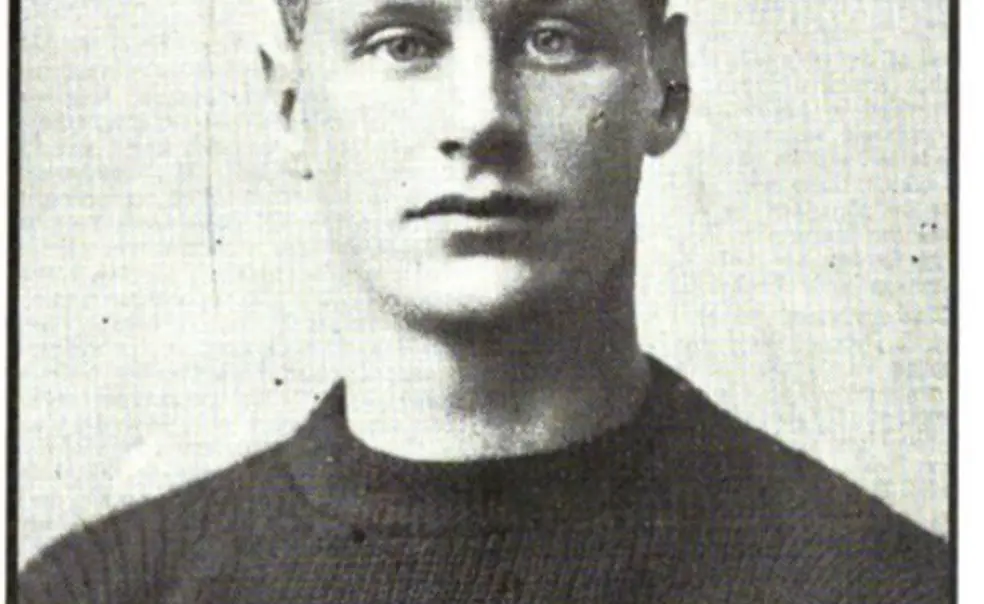The Hobart Baker Memorial: Hobey Baker '14
Through the generosity of an anonymous donor 100,000 has been presented to Princeton toward a fund for the building of an artificial ice skating rink as a memorial to the late Hobart A. H Baker ‘14. This important addition to our equipment for athletics will be an appropriate memorial to “Hobey” Baker, who was universally recognized as the States, and who as captain of both the best amateur hockey player in the United States, and who as captain of both te football and hockey teams, will always be remembered as a brilliant athlete who exemplified the highest type of American manhood, and who when the call of patriotism came, willingly sacrificed his life in the cause of liberty and justice. The skating rink will be of general service to the university community, and will provide a place for the hockey teams to practice and play their games under the most favorable conditions, - such a place as has long been needed at Princeton. Heretofore our hockey teams have been greatly handicapped by the lack of good ice on which to practice, for, although we have Lake Carnegie, the weather conditions at Princeton are such that we cannot depend upon having a good skating surface for any length of time, and our hockey teams have been obliged to go to New York and Philadelphia both for practice and for games with other teams.
The Baker Memorial is to be a Gothic building which will be a credit to Princeton architecture. The estimated cost is $250,000. With $100,000 already assured, donations for the additional $150,000 are now being obtained with the understanding that the obtaining of these donations is not to interfere in any way with the Endowment Fund campaign. A committee to confer on the completion of the building is being formed with Percy R. Pyne ‘03 as Chairman and H. G. Treadwell ‘09 as Secretary and Treasurer. Among those who have been invited to serve on the committee are Cyrus McCormick ‘12 of Chicago, Benjamin B. McAlpin Jr. ‘21 New York; Grant Peacock ‘16 New York; Charles A. McClintock ‘07, Pittsburgh; James A. Blair, Jr. ‘03, New York; Irving Brokaw ‘93, New York; Jay Cooke, II ‘19, Philadelphia; J.Keasley Mitchell ‘92, Philadelphia; David Mahany ‘08, New York; Henry J. Cochran ‘00, New york; Dixon Q. Brown, ‘95, New York; George M. Church ‘15, Tenafly, N.J. Edgar Palmer ‘03, New York; and Wendel S. Kuhn ‘14, Santa Barbara, Cal. Credit is especially due to Mr. Treadwell for the preliminary work which has brought about the realization of this project in which Henry B. Thompson ‘77, Chairman of the Trustee’s Committee on Grounds and Buildings; Controller George C. Winstringer ‘94, Dean Howard McCleanahan ‘94, Secretary H. Alexander Smith of ‘01, Nathaniel Dain ‘07, J.D. Dusenberry ‘10, and George W. Glick, Jr. ‘16 has given hearty cooperation and made many helpful suggestions.
The skating rink will be located on the southern side of Brokaw Field, where work has already been started on the excavations. While the building cannot be completed till next spring, it is expected that the ice surface will be ready for use by the first of February, so that the hockey team may have its practice and play the later games of its schedule in Princeton. The building will be constructed of stone from the university quarries and will be 256 feet in length by 126 feet in width. This will provide for an ice surface 200 feet long and 85 feet wide, which will be surrounded by tiers of seats with a capacity of 2500, and there will be standing room for 500 more. Over the ice surface the building will be one story high and the eastern end will have three stories, in which there will be two rooms for teams, with showers and lockers- one room for the home team and one for the visiting team; in this end there will also be a trophy room checking room, and retiring rooms for men and women. The engine room will be placed in the basement.
In height the building will be approximately fifty feet, with a tower forming the entrance at the eastern end. The roof will be of slate.
The method of construction of the floor of the rink will be, first, a concrete slab; second, a four inch layer of cork embedded in asphalt, and third, three-ply asphalt, water proofing. On top of the latter will be placed the brine pipers, of which there will be fourteen miles. The ice plant will be electrically driven from the University Power Plant. The large ice surface will permit plenty of action in the hockey games.
The architects of the memorial are Coy & Rice of New York, with whom George W. GLick, Jr. ‘16, is associated as an engineer. The contract for the construction of the rink has been awarded to the United Fireproofing Company of New York, of which J.D. Dusenberry ‘10 is President, Edward G. Matthews ‘07 is Vice-President and Treasurer. When completed the rink is to be maintained under the control of the Athlete Association, which will assume the responsibility for its maintenance. As it is estimated that the drink can be operated at about $5,000 a year, with its large seating capacity and other sources of revenue it should prove an asset for the Association. Certainly it will give Princeton one of the finest skating rinks in the country.
Captain Baker’s Career
The committee in charge of the completion of the fund for the Baker Memorial wishes us to say that all admirers of “Hobey” Baker, whether or not they are Princeton men, are invited to contribute to the fund, and that any contribution, no matter how small, will be gratefully received. Combining very usual skill with the highest sense of honor, always “playing the game” because he loved it and not merely for the sake of winning, Captain Baker was universally admired, and it is fitting that all who shared in that admiration should also share in this memorial to the ideal scholar in athletics and gentleman in war.
The son of the late Alfred T. Baker ‘85 halfback on the varsity football team, from his boyhood “Hobey’ Baker excelled in athletics. At St.Paul’s School he was an all-round “star,” excelling especially in hockey. He signaled his entrance at Princeton by winning the freshman football game from Yale by a brilliant run for a touchdown. He was also a member of the freshman baseball team. During the next three years he played halfback on the varsity eleven and his drop-kicking and catching of punts were important factors in Princeton’s playing. He helped defeat both Yale and Harvard in 1911, and no team he played on was defeated by Yale. He was unusually reliable in handling kicks and took them on the run, and had the remarkable record of never having fumbled a punt. He was football captain in his senior year. He was even more brilliant as a member of the hockey team for three years. In this, his favorite sport. He was in a class by himself, and it was largely due to his skill on the ice that Princeton held such a high place in this branch of athletics during his undergraduate years. He was captain of the hockey team in his junior year, but declined a reelection in his senior year. He was prevented by the two sports rule from playing on the baseball team.
Captain Baker always maintained a high scholastic record, and was a member of the Senior Council and universally popular. For a year after his graduation he was with J.P. Morgan & Co, in New York and then joined his father’s firm in Philadelphia.
More than a year before America’s entry into the war Captain Baker took up flying with the idea of putting himself for service. As might have been expected he excelled in flying as he had in football and hockey. In 1917 he went to France as a First Lieutenant among the first of the American pilots. He joined the famous Lafayette Escadrille, in which he soon gained a reputation for skill and daring. Later he commanded the 141st Aero Squadron. He was one of those officially credited with bringing down three enemy planes and was decorated with the Croix de Guerre for “exceptional tailor under fire.” He met his death accidentally in flight at Toul on Dec 26, 1918.
Major Charles J. Biddle ‘11, who was associated with Captain Baker in the airs service, said of him in the Weekly shortly after his death:
“As a squadron commander, Captain Baker was very successful, for the officers and men under his command loved and admired him as did all who knew him. His pilots knew that he would never ask them to undertake anything which he would not do himself, and that in him they had a friend who was constantly watching over their safety and who would never forsake them, regardless of the consequences to himself. os em;osted men knew that he was always thinking of their welfare and comfort and that any order which came from Captain Baker would be just and fair. I well remember one day last November when a patrol returning from the lines reported that it had last seen Captain Baker engaged in a hard fight with half a dozen Hun single-seaters and that they were afraid that he had gone down in the unequal fight. A look of consternation spread among the men, which was succeeded a few minutes later by a cheer, as the captain’s machine with its orange and black markings- he had adopted the Princeton colors and a Princeton tiger as the distinguishing mark of his squadron was seen returning from the lines. Hobey had attacked a German formation by himself and had gotten into hot water, but with his unusual skill and presence of mind had extricated himself with nothing worse than a bullet through one wing.
“As a pilot, Captain Baker was one of the very best; he enjoyed flying and handled his machine with the greatest skill. I have never known a man who was more eager to fly or who tried harder to give to his country the very best that was in him. He fought whenever the opportunity offered and always with the most fearless courage. With all his great bravery, he at the same time used his head at all times and realized that there is a wide difference between true courage and foolhardiness, but is really playing into the hands of the enemy. The only reason that Captain Baker’s score in German machines was not higher was because the chances which came to him were few. Had he had them or had the war continued, there is no doubt that his tally would have been a long one. During his service at the front he at all times flew the Spad single-seater pursuit machine and was entirely enraged inpoursuit work.
“As a man Captain Baker was a drinking example of the finest that an American can produce. In the course of several months of living and flying with him on the road I came to know him intimately. He was a thorough gentleman and a true friend on whom one could always rely. hew was entirely unselfish and always thinking of others rather than of himself and I remember one occasion on which I was as his commanding officer had practically to order him to take credit for the destruction of the German plane, which by all the reports he was a possibility that some of his pilots might have had something to do with it, and he therefore wished to withdraw in their favor. In spite of all the well deserved praise that was heaped upon him for his success in athletics and in the service he was totally unspoiled by it and he was modest almost to a fault “His record as an officer was a splendid one, and he was son of whom Princeton may well be proud.”
This article was featured in the 22nd Volume published December 14th, 1921











No responses yet